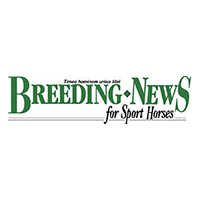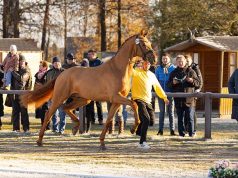By Christopher Hector
Bred by T. Essayan, Cor de la Bryère stood at Siethwende from 1971 go 1984, Zangersheide 1985, Elmshorn 1986 to 1988, and Sollwittfeld from 1989 until his death in 2000. Christopher Hector examines the life and influence of one of the greatest jumping sires.
For decades it seemed that every foal born in the Holstein breeding district was blessed with a name that began with the letter ‘C’ – though there were two C lines, and they were very different. The home-grown C line, flowed from Capitol, which was the line dubbed by noted Dutch jumping horse breeder Jan Grève as ‘the dumb power line’, while the other C was the ‘clever C’, the descendants of Cor de la Bryère. It was a dialectic that saw Holstein dominate jumping breeding, and it is only recently that a few Ds, thanks to another great French stallion, Diamant de Sémilly, are starting to make their presence felt.
Dubbed ‘Corde’
Back to the stallion the locals dubbed ‘Corde’. Once again we find a French stallion who was to play a crucial role in the development of the modern German jumping horse, and another stallion that was dismissed as a youngster by breeding authorities in his own country. ‘Just a useful gelding’ was the ‘expert’ assessment, yet Cor de la Bryère is the stallion that revolutionised jumping horse breeding. His name is the one astute breeders like to see, especially on the mare line, for ‘Corde’ tends to give great form over a jump.
His sire, the French Thoroughbred, Rantzau xx, was bred to be a jumper, being a descendant of the enormously influential, Bay Ronald xx. Rantzau was by Foxlight by Foxhunter by Foxlaw by Son-In-Law by Dark Ronald by Bay Ronald. A serious racehorse, Rantzau was the third ranked three-year-old of his year – in nine races between 2000 and 3000 metres, he won two and was placed five times.
Purchased by the National Stud, he arrived at the stallion depot of Saint-Lô on January 5th, 1951. Of Rantzau, the stud inspector noted: ‘good front extension, remarkably built through the shoulder and fore-arm, long haunches, this classy stallion of rare nobility, also has low-placed joints and covers ground.’
According to Pascal Renauldon, in his article, Cor de la Bryère, a gift from heaven (Z Magazine, February 1998) Rantzau had an unfortunate reputation: “Rumours were going around about this smart-looking and harmoniously built stallion with his rather steep shoulder. Rantzau offspring were difficult horses, one said. When De Villeneuve became director of the state stallion depot Saint-Lô, the Thoroughbred was 17 and had never served more than three mares per season.”
According to the June 1980 edition of L’Eperon: “His sons Nez de Cuit, Prince, and Quelqu’Un were presented to the selection purchase committee, but were not used by the depots in Saint-Lô and Le Pin because Rantzau allegedly produced difficult progeny. In the end it was the riders – who travel more than breeders – who discovered that these horses were far from useless, to the contrary in fact, they proved great sport horses. Only then Rantzau’s popularity began to grow… but by that time he was 20 years old. People talked about Rantzau as if he was a wild animal, but he was not. As long as his offspring were handled at an early stage, halter-broken and cared for, they would not be difficult at all… Rantzau did not acquire the reputation of a first-class progenitor, but most of the breeders who ran him down at the time would have been only too happy now if they had used him.”
However, Jean Delannoy, in the 2000 edition of the Annuaire du Cheval de Sport et d’Elevage, tells a somewhat different story: “Traditionally, the National Stud sent stallions with big frames to the south of the Manche [a French coastal department within Normandy] to alleviate the effects of the soil which made animals with a ‘reduced size’. Little by little, big-bodied broodmares were found in the Avranchin [western or lower Normandy], those which were often somewhat heavy, and would cross beautifully with a handsome Thoroughbred... To read the complete article you need to be a subscriber
CLICK HERE TO SUBSCRIBE TO BREEDING NEWS
SUBSCRIBERS CAN READ THE COMPLETE ARTICLE BY LOGGING IN AND RETURNING TO THIS PAGE




